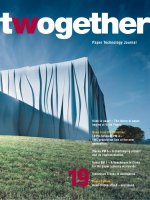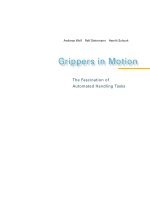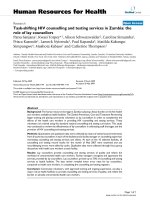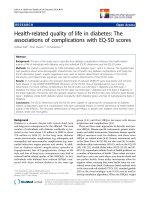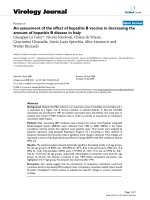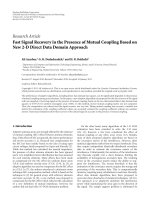Grippers in Motion - the Fascination of Automated Handling Tasks - Wolf Part 2 ppsx
Bạn đang xem bản rút gọn của tài liệu. Xem và tải ngay bản đầy đủ của tài liệu tại đây (670.73 KB, 20 trang )
start
gripping moving placing
• ambient conditions: type, temperature
• workpieces: orientation, quantity, position, size, type
Influencing factors
Figure 1.3 Phases of a handling process and its ambient conditions
Handling: The Underrated Process
1
The handling process can be basically characterized by counting the
workpieces moved per unit of time. This characteristic, however,
does not specify the amount of technical requirements for obtaining
a desired cycle time. Complex workpieces and multiple ambient
conditions can create different handling tasks to such an extent
that a simple task of moving a workpiece from point A to B can
become an extremely complex process. Human beings are naturally
equipped with an enormously flexible “gripping technique”,
efficient “sensors” and highly complex “data processing” and,
therefore, tend to underrate such tasks.
From practical experience in automation projects we know that
unexpected technical and economic problems tend to occur
especially when the handling process and all its parameters are not
sufficiently analyzed and evaluated at an early stage.
22
}À««}ÊÌ>Ã
ÜÀ«iViÊvi>ÌÕÀiÃ
ÜÀ«iViÊÃÌ>ÌÕÃÊ
`ÕÀ}Ê«V>`«>ViÊ«iÀ>ÌÃ
Û}ÊÌ>Ã
>LiÌÊV`ÌÃ
vi>ÌÕÀiÃÊvÊ
ÜÀ«iViÉ}À««iÀÊ
VL>Ì
ÛiiÌÊ
vi>ÌÕÀiÃÊ
}ÕÀiÊ£°{Ê/iÊ>`}Ê«ÀViÃÃÊÃÌÀÕVÌÕÀ>ÊÛiÀÛiÜ®
/ÃÊLÊÌi`ÃÊÌÊÃÜÊÜÊÌiÊ>ÕÌ>ÌÊvÊ>`}ÊÌ>ÃÃÊ
V>ÊLiÊ>ÃÌiÀi`ÊÊÌiÊL>ÃÃÊvÊÌiVV>ÊÜÜÊ>`Ê>««À«À
>ÌiÊV«iÌÊ«>ÀÌðÊÜÜÊvÊÌiÊyÕiV}Êv>VÌÀÃÊvÊ>Ê
>`}Ê«ÀViÃÃÊV>ÊLiÊ`Û`i`ÊÌÊ}À««}ÊÌ>ÃÊvi>ÌÕÀiÃÊ>`Ê
Û}ÊÌ>ÃÊvi>ÌÕÀiðÊ
/iÊ}À««}ÊÌ>ÃÊÃÊ>ÞÊ`iÌiÀi`ÊLÞÊÌiÊÜÀ«iVi]ÊÌÃÊÊ
vi>ÌÕÀiÃ]Ê>`ÊÌiÊÜÀ«iViÊÃÌ>ÌÕÃ]ÊÊ°i°ÊÜÊÌÊÃÊÃÌÕ>Ìi`°Ê
/iÊÛ}ÊÌ>ÃÊÃÊyÕiVi`ÊLÞÊÌiÊvi>ÌÕÀiÃÊvÊÌiÊÜÀ«iViÉ
}À««iÀÊVL>Ì°ÊÊ>``Ì]ÊÌiÀÊVÀÌiÀ>ÊVÃiÞÊÀi>Ìi`ÊÌÊÌiÊ
ÛiiÌÊ>ÛiÊÌÊLiÊiÌ°
/iÊ}À««}ÊÌ>ÃÊ>`ÊÌiÊÛ}ÊÌ>ÃÊ>ÀiÊ`i«i`iÌÊÊi>VÊÌiÀ°Ê
vÊ>ÊÜÀ«iViÉ}À««iÀÊVL>ÌÊÜi}ÃÊÌÊÕVÊÌiÊ>ÊÊ
«>ÀÌVÕ>ÀÊÛ}ÊÌ>ÃÊV>Ê>À`ÞÊLiÊ>>}i`ÊÀÊÌÊLiÊV«i`ÊÜÌÊ
>ÌÊ>°
ÌÊ}À««}Ê>`ÊÛ}ÊÌ>ÃÊ>ÀiÊÃÕLiVÌÊÌÊÌiÊÃ>iÊ>LiÌÊ
V`ÌÃÊvÊÌiÊ«À`ÕVÌÊ«ÀViÃÃ]ÊÃÕVÊ>ÃÊ}ÉÜÊÌi«iÀ>ÌÕÀiÊ
ÀÊ>ÀÃÊiÛÀiÌð
Ê
ÓÎ
>`}\Ê/iÊ1`iÀÀ>Ìi`Ê*ÀViÃÃ
£
£°ÓÊ >`}Ê/iÀ}Þ
/iÊvÜ}Ê`iwÌÃÊ>ÀiÊ}ÛiÊÌÊÌÀ`ÕViÊÌiÊÀi>`iÀÊÌÊÌiÊ
ÌiVV>ÊÌiÀÃÊvÊ>`}Ê>`Ê>ÀiÊÕÃivÕÊvÀÊÕ`iÀÃÌ>`}ÊÊ
ÌiÊvÜ}ÊV>«ÌiÀðÊ/iÊÀ`iÀÊvÊÌiÀÃÊ>««ÀÝ>ÌiÞÊvÜÃÊ
ÌiÊ«À`ÕVÌÊ«ÀViÃð
iÝLÌÞÊÊ
6iÀÃ>ÌÌÞÊ>`Ê>`>«ÌÊyiÝLÌÞÊ>ÀiÊÌÊLiÊ`ÃÌ}ÕÃi`°Ê6iÀÃ>ÌÌÞÊ
ÃÊ`iwi`Ê>ÃÊ>Êi>ÃÕÀiiÌÊvÀÊÌiʵÕ>ÌÌÞÊvÊ`vviÀiÌÊÜÀÊ
«ÀViÃÃiÃÊÜVÊV>ÊLiÊ>>}i`ÊLÞÊ>Ê«À`ÕVÌÊÃÞÃÌi°ÊÊ
6iÀÃ>ÌÌÞÊiÝ«ÀiÃÃiÃ]ÊÌiÀivÀi]ÊÌiÊ«ÀL>LÌÞÊvÊ>>}}Ê>ÞÊ
«À`ÕVÌÊÌ>ÃÊÜÌÊ>Ê`iwi`ÊÀ>}iÊvÊÃÕVÊÌ>Ãðʫ>À}Ê
ÌiÊÛiÀÃ>ÌÌÞÊvÊ`vviÀiÌÊ«À`ÕVÌÊÃÞÃÌiÃÊ>iÃÊÞÊÃiÃiÊÊ
Ài>ÌÊÌÊÌiÊÃ>iÊÀ>}iÊvÊ«>ÀÌÃÊÌÊLiÊ«À`ÕVi`°
`>«ÌÊyiÝLÌÞÊ`iwiÃÊ>Êi>ÃÕÀiiÌÊvÀÊ>Ê«iÀ`ÊvÊÌiÊ>`Ê
ÌiÊVÃÌÃÊÜVÊ>VVÀÕiÊ`ÕÀ}ÊÌiÊÌÀ>ÃviÀÊvÀÊiÊÜÀÊ«ÀViÃÃÊ
ÌÊÌiÊiÝÌÊÜÌÊ>Ê«À`ÕVÌÊÃÞÃÌi°
«ÕÌÊÊÀi>ÌÊÌÊ>Ê}ÛiÊÕÌ«ÕÌÊÃÊ`iwi`Ê>ÃÊ«À`ÕVÌÛÌÞ°Ê
Ý>«i\
Ó{
7À«iVi
/iÊÌiÀÊÃÊÌ>iÊvÀÊÌiÊwi`ÊvÊiV>V>Ê«ÀViÃÃ}°ÊÃÊ>ÊÀÕiÊ
ÌiÊÜÀ«iViÊÕ`iÀ}iÃÊ>Ê«ÞÃV>Ê>«Õ>ÌÊ`ÕÀ}Ê«ÀViÃÃ
}°Ê7iÊÛ}ÊÜÀ«iViÃÊÌiÊvVÕÃÊÃÊÌÊÊ«ÀViÃÃ}ÊÌÃivÊ
LÕÌÊÊV>}}ÊÌiÊ«ÃÌÊ>`ÊÀiÌ>ÌÊvÊÌiÊÜÀ«iVi°Ê
ÊÌÃÊVÌiÝÌÊÌiÊÜÀ«iViÊÃÊvÌiÊV>i`ÊÌiÊ>`}ÊLiVÌ]Ê
ÃÞÞÃÊ>ÀiÊ>ÃÊÜÀÊLiVÌ]Ê«À`ÕVÌ]Ê«ÀViÃÃ}Ê«>ÀÌ]ÊÀÊV
«iÌÊ«>ÀÌ°ÊÊÌiÊvÜ}]ÊÌiÊÌiÀÊÜÀ«iViÊÜÊLiÊÕÃi`Ê
Ài}>À`iÃÃÊvÊÜiÌiÀÊÌiÊV«iÌÊ«>ÀÌÊÃÊ«ÀViÃÃi`]ÊÛi`ÊÀÊ
ÀiÌi`°
7À«iViÊV«Õ`
Ê`ÃÌVÌÊÕÃÌÊLiÊ>`iÊLiÌÜiiÊ>ÊÃ}iÊÜÀ«iVi]ÊÃÕVÊ>ÃÊ
iÊÌ>ÌÊÃÊÜÌÕÌÊÌiÀÊÜÀ«iViÃÊi>ÀLÞ]Ê>`ÊLiÌÜiiÊ>ÊV
«Õ`°Ê/iÊV«Õ`ÊÃÊ`iwi`ÊÜiÊÌiÊÜÀ«iViÃÊ>ÀiÊ>`i`Ê
ÊiÊiÛiÊÀÊÜiÊÌiÞÊ>ÀiÊÃÌ>Vi`ÊÊÌ«ÊvÊi>VÊÌiÀ°Ê
/
/ÃÊ>ÀiÊÕÃi`ÊvÀÊ«ÀViÃÃ}ÊÜÀ«iViðÊÊ}iiÀ>Ê`ÃÌVÌÊ
`ÕÀ}Ê>`}ÊÃÊ>`iÊLiÌÜiiÊ>`}ÊÌiÊÌÊ
>`Ê>`}ÊÌiÊÜÀ«iVi°Ê
7À«iVi\ÊiÝLiÊ`ÀÛiÊÃ>vÌ
Ý>«iÃÊvÊÜÀ«iViÃ
Óx
handling
VDI 2860
conveying
VDI 2411
storing
VDI 2411
effecting
materials flow
Handling: The Underrated Process
1
Setup
The term is used in connection with the availability of workpieces.
A workpiece is made ready when it is able to be gripped.
Handling
Handling means creating, defined changing or temporarily maintain-
ing a pre-set alignment of geometrically defined bodies in a
system of coordinates. Further parameters such as time, quantity,
and path can be pre-set (source: VDI Verein Deutscher Ingenieure
Guideline 2860).
Handling is a subfunction of the materials flow and categorized on
the same level as conveying or storing.
Handling is divided into the following single steps:
• Store
• Change Quantities
• Move
• Secure
• Control
26
-ÌÀi >}iÊ+Õ>
ÌÌiÃ
Ûi -iVÕÀi ÌÀ
>ÃVÊvÕV
ÌÃ
UÊ`Û`iÊ
UÊÕÌi
UÊÀÌ>ÌiÊ
UÊÃvÌ
UÊ`Ê
UÊÀii>Ãi
UÊÌiÃÌ
«iÝÊ
vÕVÌÃ
UÊÃÌÀi` UÊÃi«>À>ÌiÊ
UÊ>V>ÌiÊ
UÊLÀ>VÊ
UÊÊ
UÊÃÀÌÊ
UÊÃÜÛiÊ
UÊÀiÌÊ
UÊ«ÃÌÊ
UÊ>ÀÀ>}iÊ
UÊ}Õ`iÊ
UÊV>«ÊÊ
UÊÕV>«
UÊi>ÃÕÀiÊÊ
UÊVÕÌ
,i>â>Ì UÊVÛiÞÀÊLiÌÊ
UÊ«>iÌÊ
UÊ>}>âi
UÊÃ>ÌÊ`iÛViÊ
UÊ>V>ÌÀÊ
UÊÃÜÌV
UÊÀÌ>ÀÞÊ`iÛViÊ
UÊi>ÀÊ>ÝÃÊ
UÊ`ÕÃÌÀ>ÊÀLÌ
UÊ«>À>iÊ>ÜÊÊ
ÊÊ}À««iÀÊ
UÊÌi}À>ÌÀÊ
UÊë>iÀ
UÊÌiÃÌ}Ê`iÛViÊ
UÊi>ÃÕÀ}Ê`iÛViÊ
UÊÃiÃÀ
ÊÌ>LiÊ£°ÓÊÌiÃiÊÃ}iÊÃÌi«ÃÊvÊ>`}Ê>ÀiÊvÕÀÌiÀÊ`Û`i`ÊÌÊ
L>ÃVÊvÕVÌÃÊ>`ÊV«iÝÊvÕVÌðÊÊvÕVÌÃÊ>ÀiÊÀi>Ìi`ÊÌÊ
ÌiÊÜÀ«iViÊÀÊÌiÊÜÀ«iViÊV«Õ`°Ê
Ê
7iÊÌiÊ«>ÀÌ>ÊvÕVÌÃÊ-ÌÀiÊ>`Ê>}iÊ+Õ>ÌÌiÃÊ>ÞÊ
VVÕÀÊ`ÕÀ}ÊÜÀ«iViÊÃiÌÕ«]ÊÌiÊvÕVÌÃÊÛiÊ-iVÕÀiÊ>ÀiÊ
iVÕÌiÀi`ÊÜiÊV>}}ÊÌiÊÜÀ«iViÃÊÀ`iÀÊÃÌ>ÌÕðÊÊ
/iÊÌÀÊvÕVÌÊÃÊ>Ê>``Ì>ÊvÕVÌÊÜVÊÃÊÀi}Õ>ÀÞÊ
>ÃÃV>Ìi`ÊÜÌÊ>`}°ÊÕÃÌÊ>ÃÊ>ÊÕ>ÃÊÜÕ`ÊiÝ>iÊÌiÊ
ÜÀ«iViÃÊÜiÊ«V}ÊÌiÊÕ«]ÊÌiÊÜÀ«iViÃÊÊ>Ê>ÕÌ
>Ìi`Ê«ÀViÃÃÊ>ÛiÊÌÊLiÊÌÀi`]ÊÌ°
ÀÊÌiÊÛiÊ>`Ê-iVÕÀiÊvÕVÌÃÊÌÊÃÊiÃÃiÌ>ÊÜÊÌiÊÜÀ
«iViÃÊ>ÀiÊ«Ài«>Ài`Ê>`Ê«ÀiÃiÌi`°Ê6>ÀÕÃÊÌiVV>Ê«ÌÃÊ>ÀiÊ
ÃÜÊÊÌiÊLÌÌÊiÊvÊÌ>LiÊ£°Ó°Ê/iÊ->ÛiÊvÕVÌÊvÀÊÜÀ
«iViÃÊV>ÊLiÊÀi>âi`ÊLÞÊVÛiÞÀÊLiÌ]Ê«>iÌ]ÊÀÊ>}>âi°ÊÊ
/iÃiÊÃ>Û}Ê«ÌÃÊ`vviÀÊ>VVÀ`}ÊÌÊÃ>Û}ÊÛÕi]ÊÃ>Û}Ê
VÃÌÃÊ>`ÊÜÀ«iViÊÀ`iÀÊÃÌ>ÌÕðÊ/iÊvÕVÌÊ>}iÊ+Õ>ÌÌiÃÊ
>ÞÊ>ÛiÊÌÊLiÊÌi}À>Ìi`Ê>ÃÊ>ÊÌiÀÊ«ÀViÃÃÊÌÊLiÊ>LiÊÌÊÊ
}À«ÊÌiÊÜÀ«iVi]Êi°Ê}°ÊÕÃ}ÊÛLÀ>Ì}Ê`iÛViÃÊÀÊ>V>ÌÀÃÊvÀÊ
Ã>Ì}ÊÌiÊÜÀ«iVi°
/>LiÊ£°ÓÊ*>ÀÌ>ÊvÕVÌÃÊvÊ>`}ÊÃÕÀVi\Ê6ÊÕ`iiÊÓÈÈä®
ÓÇ
Ó
Î
x
{
£
>`}\Ê/iÊ1`iÀÀ>Ìi`Ê*ÀViÃÃ
£
ÊÀ`iÀÊÌÊÛiÊ>ÊÜÀ«iViÊvÀÊ«ÌÊÊÌÊÊLÌÊ«>ÀÌ>ÊvÕV
ÌÃÊ-iVÕÀiÊ>`ÊÛiÊ>ÀiÊÀiµÕÀi`°Ê/iÊÌiVV>ÊÌÃÊ>`Ê
V«iÌÃÊvÀÊÌiÃiÊvÕVÌÃÊ>ÀiÊÌiÊÃÕLiVÌÊvÊÌÃÊ«ÕLV>Ì°Ê
iVV>Ê}À««iÀÃÊ>ÀiÊ>««À«À>ÌiÊvÀÊÃiVÕÀ}ÊÌiÊÜÀ«iViðÊ
À««}Ê>`ÊV>«}Ê`iÛViÃÊ>ÀiÊÕÃi`ÊÊÀi>ÌÊÌÊÌiÊ>ViÊ
«iÀ>Ì°Ê«iÌÃÊvÀÊÌiÊÛ}Ê«ÀViÃÃÊÀ>}iÊvÀÊÀÌ>Ì}Ê
ÀÊÃÜÛi}Ê`iÛViÃÊÌÊi>ÀÊ>ÝiÃÊÌÊ`ÕÃÌÀ>ÊÀLÌðÊ
£Ê>`}Ê`iÛViÊÉÊÛ}Ê`iÛVi
Û}Ê`iÛViÃÊ>ÀiÊÌiVV>Ê`iÛViÃÊÜVÊi>LiÊ>ÊÜÀ«iViÊ
ÌÊLiÊÛi`°Ê/ÃÊVÕ`iÃÊÌiÊëiÃÌÊÛiiÌÃÊÃÕVÊ>ÃÊ«ÕÀiÊ
ÀÌ>ÌÃÊÀÊi>ÀÊÛiiÌÃÊvÊÌiÊÜÀ«iViÊ>ÃÊÜiÊ>ÃÊV«iÝÊ
ÛiiÌÃÊLÞÊ`ÕÃÌÀ>ÊÀLÌð
ÓÊ`>«ÌÊÉÊy>}iÊ>`>«ÌiÀÊ
ÊÀ`iÀÊÌÊVLiÊÌiÊ}À««iÀÊ`ÕiÊÜÌÊ>Ê>`}Ê`iÛViÊ
Û}Ê`iÛVi®]ÊvÀÊiÝ>«iÊ>Ê`ÕÃÌÀ>ÊÀLÌ]Ê>`>«ÌiÀÃÊ>ÀiÊ
ii`i`ÊÌÊViVÌÊÌiÊÌiÀv>ViÃÊvÊLÌÊÃÞÃÌið
ÎÊÀ««iÀÊ`Õi
À««iÀÊ`ÕiÊÃÊ`iwi`Ê>ÃÊÌiÊ}À««}ÊV«iÌÊÜVÊ
VLiÃÊ`ÀÛiÊ>`Êi>ÌVðÊÀ««iÀÊi>ÌVÃÊ>ÀiÊ`iwi`Ê>ÃÊ
ÌiÊ«>ÀÌÊvÊÌiÊ}À««iÀÊ`ÕiÊÜVÊÌÀ>ÃvÀÃÊÌiÊÛiiÌÊvÊ
>Ê>VÌÕ>ÌÀÊ`ÀÛi®ÊÌÊ>ÊÛiiÌÊvÊÌiÊ}À««}Êw}iÀÃÊÀÊÌiÊ
vÀViÌÀ>ÃviÀÊiiiÌðÊ/iÊ}À««iÀÊ`ÀÛiÊÃÊ`iwi`Ê>ÃÊÌiÊ«>ÀÌÊvÊ
>Ê}À««iÀÊ`ÕiÊÜVÊÌÀ>ÃvÀÃÊÌiÊ«ÕÌÊ«ÜiÀÊÌÊ>ÊÀÌ>ÀÞÊÀÊ
ÌÀ>Ã>ÌÀÞÊÛiiÌ°
{Ê7À«iVi
7À«iViÊÃÊ`iwi`Ê>ÃÊÌiÊLiVÌÊÌ>ÌÊÃÊÌÊLiÊ}À««i`°Ê/iÊÜÀ
«iViÊÌÃivÊÃÊÌÊV>}i`ÊÀÊ>«Õ>Ìi`ÊLÞÊÌiÊ>`}°
xÊÀ««iÀÊw}iÀÊÉÊvÀViÊÌÀ>ÃviÀÊiiiÌ
À««iÀÊw}iÀÊÀÊvÀViÊÌÀ>ÃviÀÊiiiÌÊ`iwiÃÊÌiÊ«>ÀÌÊvÊ>Ê}À««iÀÊ
ÜVÊ`ÕViÃÊÌiÊ>««À«À>ÌiÊvÀViÊÊÌiÊÜÀ«iViÊÊÀ`iÀÊÌÊ
ÀiÌ>ÊÌÊ>}>ÃÌÊÌiÊ«ÀViÃÃÊvÀVi°
}ÕÀiÊ£°xÊiwÌÊvÊ>Ê}À««iÀÊÃÞÃÌi
Ón
À««iÀÊ-ÞÃÌiÊ
/iÊÌiÀÊ}À««iÀÊÃÞÃÌiÊÃÌ>`ÃÊvÀÊ>ÊV«iÝÊ}À««iÀÊÜVÊ>ÞÊ
VÃÃÌÊvÊÃiÛiÀ>ÊÃÕLÃÞÃÌiðÊ/iÊvÀViÊÌÀ>ÃviÀÊiiiÌÃÊÊ>Ê
ëiÊw}iÀÊvÀÊV>ÊLiÊVw}ÕÀi`Ê>ÃÊ>ÊV«iÌiÊ«>Þ>`ÊÃÞÃÌiÊ
ÀÊi`ivviVÌÀÊV>«>LiÊvÊ}À««}ÊiÊÀÊÃiÛiÀ>ÊÜÀ«iVið
ÊV>ÃiÊvÊ`vviÀ}ÊÜÀ«iViÊÃâiÃÊÀiµÕÀ}Ê`vviÀiÌÊ«ÃÌ
}ÊvÊÌiÊi`ivviVÌÀÃ]Ê`ÀÛiÊÃÞÃÌiÃÊ>VÌÕ>ÌÀîÊ>ÀiÊvÀiµÕiÌÞÊ
iViÃÃ>ÀÞÊÌÊ«ÕÌÊÌiÊ}À««iÀÊ>ÜÃÊÌÊ«ÃÌ°Ê«iÝÊ}À««iÀÊ
ÃÞÃÌiÃÊÀiµÕÀiÊëiV>ÊVÌÀÊÃÞÃÌiÃÊÜVÊV>ÌÊ>Ü>ÞÃÊLiÊ
Ìi}À>Ìi`ÊÌÊÌiÊ}À««iÀÊÌÃiv°Ê-iÃÀÊÃÞÃÌiÃÊ«ÀÛ`iÊÌiÃiÊ
VÌÀÊÃÞÃÌiÃÊÜÌÊÌiÊiViÃÃ>ÀÞÊvÀ>ÌÊvÀÊ>VÌÕ>Ì}ÊÌiÊ
i`ivviVÌÀðʫ«À«À>ÌiÊÃ>viÌÞÊÃÞÃÌiÃÊ>ÀiÊ>ÌiÀÊ`i>`ÊÊ
}À««iÀÊÌiV}Þ°
ÃÊ>ÊÀiÃÕÌ]ÊV«iÌiÞÊ`i«i`iÌÊ}À««iÀÊÃÞÃÌiÃÊV>ÊLiÊVÀi>Ìi`Ê
ÜÌÊ>ÊVÃ`iÀ>LiÊ«>VÌÊÊÌiÊvÕVÌ>ÌÞÊvÊÌiÊÛiÀ>Ê«À
`ÕVÌÊ«ÀViÃð
/iÊ}À««iÀÊÃÞÃÌiÊVÃÃÌÃÊvÊÃiÛiÀ>Ê
ÃÕLÃÞÃÌiÃ]ÊÜVÊ>ÀiÊÌÊÌi`ÊÌÊ
ÌiÊ}À««}Ê«ÀViÃÃ]ÊÃÕVÊ>Ã\
UÊ«>Þ>`ÊÃÞÃÌiÃÊ
UÊi`ivviVÌÀÃ
UÊ`ÀÛiÊÃÞÃÌiÃÊ
UÊVÌÀÊÃÞÃÌiÃÊ
UÊÃiÃÀÊÃÞÃÌiÃÊ
UÊÃiVÕÀÌÞÊÃÞÃÌiÃÊ
Ów}iÀÊÊ
«>À>iÊ}À««iÀÊ
ÌiÀ>ViÊÊ
V«iÃ>Ì
ÃiÀÛiiVÌÀVÊÊ
ÀÌ>ÀÞÊw}iÀÃ
}ÕÀiÊ£°ÈÊÝ>«iÊvÊ>Ê}À««iÀÊÃÞÃÌi
Ó
Handling: The Underrated Process
1.3 What Are The Main Points of This Book?
The following chapters focus on the realization of handling technol-
ogy tasks. Keynote is the process of integrating a workpiece into a
moving device and put it into a new position or orientation.
In order to illustrate the subject in a sensible selection we draw
the analogy to human object handling. In line with this analogy we
concentrate on gripping techniques which follow mechanical
principles (force-lock and/or form-lock). Vacuum grippers and other
gripper types are included but not covered in detail. However, work-
piece movement with moving axes and robot technology from the
gripper finger to the six-axis robot arm are thoroughly described.
Chapter 1 explains terms and fundamentals of the subject.
Chapter 2 gives an insight into the history of automation technol-
ogy and robot development over the past 30 years, highlighting
the milestones without any claim for completeness. An outlook on
future developments awaiting us over the next few years, sup-
ported by statistics and statements by the German federation of
the engineering industries VDMA (Verband Deutscher Maschinen
und Anlagenbauer) is included
1
30
>`Ê>ÝÃÊ
ÃÜÛi}ÊÕÌÊ
}À««iÀÊV>}}ÊÃÞÃÌiÊ
`ÀÛi
i`ivviVÌÀÊ
ÜÀ«iVi
}À««iÀÊi>ÌVÃÊ
>Ê>ÝÃÊ
ÀLÌÊ>À
ÃiÃÀÃÊ
>«ÌiÀÊÎÊiÝ«>ÃÊÌiÊÌiVV>ÊÀiµÕÀiiÌÃÊvÀÊ}À««}]ÊÃÌ>ÀÌ}Ê
ÜÌÊÌiÊÜÀ«iViÊ>ÃÊÌiÊÀi>ÃÊvÀÊ>`}°Ê/iÊVÌÀ>ÌÃÊvÊ
}À««}Ê>`ÊÌiÊÜÀ«iViÊÃiÌÕ«Ê>ÀiÊ`ÃVÕÃÃi`Ê>ÃÊÜi°
Ê>«ÌiÀÊ{ÊÜÀ«iViÊÛiiÌÊ>ÃÊ«>ÀÌÊvÊÌiÊ}À««}Ê«ÀViÃÃÊ
ÃÊ`ÃVÕÃÃi`°ÊÊL>ÃVÊÜi`}iÊvÊÀLÌVÃÊÌ>ÌÊÃÊiViÃÃ>ÀÞÊvÀÊ
>ÕÌ>Ìi`ÊÛiiÌÃÊÃÊiÝ«>i`ÊvÀÊÀi>â}ÊëiÊÀÌ>ÀÞÊ>`Ê
i>ÀÊÛiiÌÃÊÌÊÕÌi>ÌVÃÊ>`ÊÀLÌðÊ
>«ÌiÀÊxÊVÕ`iÃÊ>««V>ÌÃÊ>ÃÊ«ÀÛ`i`ÊÌÊÌiÊ>ÕÌÀÃÊLÞÊ«À
`ÕViÀÃÊÀÊÌi}À>ÌÀÃÊÕÃÌÀ>Ì}ÊÌiÊÃÕÀ«ÀÃ}ÊÛ>ÀiÌÞÊvÊ>ÕÌ>
ÌÊÃÕÌÃÊvÀÊÌiÊÃÌÊ`ÛiÀÃiÊ`ÕÃÌÀiðÊ/iÊ>««V>ÌÃÊ>ÀiÊ
>Ê`V>ÌÀÊvÀÊÌiÊ«À>VÌV>LÌÞÊvÊ>ÕÌ>ÌÊÌiV}ÞÊ>`ÊÌÃÊ
«ÀëiVÌÃÊvÀÊÌiÊvÕÌÕÀi°Ê
/iÊ}À««iÀÊ>ÀÊ>`ÊÌÃÊV«iÌÃÊ
qÊ>ÊÕÃÌÀ>Ìi`Ê}Õ`iÊÌÀÕ}ÊÌÃÊL°
Σ
iV>V>Ê}iiÀ}Ê>`ÊÕÌ>ÌÊ«iÌÃÊ
iÛi«iÌÊvÊÊ iÜÊ`ÕÃÌÀÞÊ
ÃÌÀÞÊ>`Ê-Ì>ÌivÌi>ÀÌÊ/iV}ÞÊ
`ÕÃÌÀ>Ê,LÌÊ-Ì>ÌÃÌVÃÊ
ÛÕÌÊÀÊ,iÛÕÌ
Ó
ÓÊ ÛÕÌÊÀÊ,iÛÕ̶
Ó°£Ê >}iÃÊÊÌiÊi`ÊvÊÕÌ>ÌÊ°°°°°°°°°°°°°°°°°°°°°°°°°°°°°°°°°°°° Îx
Ó°ÓÊ iÛi«iÌ>Ê-Ì>}iÃÊvÊÀ««iÀÃÊ°°°°°°°°°°°°°°°°°°°°°°°°°°°°°°°°°°°°°° În
Ó°ÎÊ ,LÌÊÃÌÀÞÊ°°°°°°°°°°°°°°°°°°°°°°°°°°°°°°°°°°°°°°°°°°°°°°°°°°°°°°°°°°°°°°°°°°°°°°°°° {x
Ó°{Ê ,LÌÊ-Ì>ÌÃÌVÃÊ°°°°°°°°°°°°°°°°°°°°°°°°°°°°°°°°°°°°°°°°°°°°°°°°°°°°°°°°°°°°°°°°°°°°° Èä
ể
ấèiấVèiíèấvấiĩấèiV}V>ấ`iiôièấèiấèiấi
ếèằấấviàếièịấ>ôôi`ấấv>Vè]ấiấvấèiấ>Viiièấấ
>ếè>èấèiV}ịấĩèấèiấô>èấẻọấịi>ấV>ấ`iwèiịấLiấ
V>i`ấiếè>ịấ"i>ấè>èèV]ấĩii]ấĩấ>ấ>èiấấ
`i>èiấô>Viấvấ`iiôièấĩấếVấvấèấấiếè]ấ>`ấ
ĩấếVấấiếèả
/iấếôi>>ấvấv>èấèiV}ịấấèiấ`ếè>ấ>ếè>èấ
>i>ấấiếè>ịấv>èấèiV}ịấ>ấLèi`ấ`ế
è>ấ>ếè>èấ>ấôiv>Viấèièịấĩ>ấếèôi`ấLịấVèấ
èiV}ịấ>`ấiấ`>è>ấôVi}ấ"èiấèiV}V>ấ
ô>Vèấ>iấiôLiấvấ>ấ}iấVViè>èấvấếèôếèấ>`ấ
vếVèấ>èấ`iVi>}ấVèấqấè>è}ấvấVô>Vèấ>Vèế>èấấ
èấ}èĩi}èấi>èVấèếVèếiấ/iấi>ấivvèấiếèấấèiấ
ếèôếèấvấ>`>Vi`ấ}èiVấịèiấĩVấ>iấLế`ấèấLiấ
ếVVivếấ/iấVèếịấVi>}ấếLiấvấLèấịèiấ
Vi>ịấôiấèấèi`
/iấi>ấVi>iấV>èấLiấV`ii`ấiếè>ịằấĩiấ
}ấ>èấLèấô`ếVèấếèôếèấw}ếiấĩVấ>iấLiiấè>èè
V>ịấiV`i`ấvấiấè>ấểọấịi>ấiôèiấè>ịấĩấếèôếèấ
`ế}ấèiấ`ầọ]ấ}i>èấiíôiVè>èấấLèVấi`ấèấèiấấ
iiVèiấôiViôèấvấ>ấèiVV>ấiếèấ->iấèấiiè}ấ
ií>}}i>èi`ấviV>èấ>`ấ>ấLi}ấivviVèấ,Lèấ>ôôV>èấ
ĩiiấèi`ấLịấ>ấè>ịấếv>>LiấôViôiv>Viấ>èấ>`ấ
>ấ>Vấvấô>}ấV>ô>Vèịấ>ấ>ấ>ếè>èi`ấĩôấiàếi`ấ
V`i>Liấô>}ấivvèấĩiấè>i`ấè>vvấ>`ấô>}ấèấ
ĩiiấèấịièấ>>>Li
1 -"ấ>ế>ịấôếLiấ>ấèi>è>ấếiịấấLèấè>
èèV>ấ`iiôièấ"èiấèèếèiấ>`ấèèếèấiV`ấLèấ
ôiViấếLiấVế`}ấ`iè>i`ấv>èấấô>ị>`ấấếLiấ
vấ>íiấấ>ếè>èấèiV}ịấVôiè]ấếVấ>ấiấ
ấ}ôôi]ấếVấ`iè>i`ấôiViấếLiấ>iấ`vwVếèấèấ`ièii
ểấ ếèấấ,iếèả
ếèấấ,iếè
ể
ẻ{
!
Ó°£Ê >}iÃÊÊÌiÊi`ÊvÊÕÌ>Ì
/iÊ}iiÀ>Ê`iÝÊLÞÊÌiÊiÀ>Êi`iÀ>ÌÊvÊÌiÊ}iiÀ}Ê
`ÕÃÌÀiÃÊ6Ê6iÀL>`ÊiÕÌÃViÀÊ>ÃViÊÕ`Ê>}i
L>ÕiÀ®Ê«ÀiÃiÌÃÊ>ÊÛiÀÛiÜÊvÊÌiÊ>ÕÌ>ÌÊ`ÕÃÌÀÞÊ>ÃÊ>Ê
Üi°Ê/ÃÊ`iÝÊÀiÛi>ÃÊÃ>iÃÊÌÀi`ÃÊÊ,LÌVÃÊ>`ÊÕÌ>ÌÊ
V«>Ài`ÊÌÊÌÀ>`Ì>ÊiV>V>Ê}iiÀ}Êw}ÕÀiÊÓ°£®°Ê
ÀÊ£{ÊÜ>À`ÃÊÌiÊVÕÀÛiÊÊÌiÊV>ÀÌÊ`V>ÌiÃÊ>ÊVi>ÀÊ}ÀÜÌÊ
À>ÌiÊÊ>ÕÌ>Ì°Ê/iÊ>ÊÀi>ÃÃÊvÀÊÌÃÊ>ÀiÊ}iÀÊivwViVÞÊ
>`Ê>ÊÜ`iëÀi>`Ê`ÃÌÀLÕÌÊvÊV«ÕÌiÀÊÌiV}ÞÊvÀÊiÀÞÊ
«À}À>ÊVÌÀÃÊÃÕVÊ>ÃÊ>}iÊ«ÀViÃÃ}ÊVÌÀiÀÃÊÀÊÀLÌÊ
VÌÀiÀðÊÊÌiÊÞi>ÀÃÊÓääÓÊ>`ÊÓääÎÊÌiÊ}ÀÜÌÊvÊÌÕÀÛiÀÊÊ
>ÕÌ>ÌÊVi>ÀÞÊiÝVii`i`ÊÌ>ÌÊvÊiV>V>Ê}iiÀ}°
/`>ÞÃÊ>ÃÃÊ>ÀiÌÃÊÜÌÊ}ʵÕ>ÌÌiÃÊ>`ÊÃÀÌÊ«À`ÕVÌÊ
VÞViÃ]ÊiÊ°}°ÊÊÌiiVÕV>ÌÃÊ>`ÊV«ÕÌiÀÊÌiV}Þ]Ê>ÀiÊ
VÕ«i`ÊÌÊÌiÊÛiÃÌiÌÊ}`ÃÊÃiVÌÀÊÌÀÕ}ÊvÀ>ÌÊÊ
ÌiV}Þ°ÊÊÌÃÊÀiëiVÌ]Ê>ÕÌ>ÌÊÌiV}ÞÊVÕ`ÊLiÊV
Ã`iÀi`Ê>ÊÌiV}V>ÊÀiÛÕÌÊvÀÊÌiÊ`äÃÊÜ>À`ðÊÊ
Ê
}ÕÀiÊÓ°£Ê/À>`}ÊÛÕiÊqÊ«ÀViÊ>`ÊÃi>Ã>ÞÊ>`ÕÃÌi`]ÊÌÕÀÛiÀÊÓäääÊrÊ`iÝÊ£ääÊÃÕÀVi\Ê6®
Îx
ÛÕÌÊÀÊ,iÛÕÌ
7iÊÜÊÜÊÌ>iÊ>ÊVÃiÊÊ>ÌÊÌiÊiÛÕÌÊvÊ}À««iÀÃÊ>`Ê
ÀLÌÃÊÜVÊ>À}iÞÊVÌÀLÕÌi`ÊÌÊÌÃÊÀiÛÕÌ°
ÌÊÃÊv>ÃV>Ì}ÊÌÊÃiiÊÜÊ«>À>iÊÌÊ«À}ÀiÃÃÊÊVÀiiV
ÌÀVÃ]Ê>VÌÕ>ÌÀÊÌiV}ÞÊ>`ÊiV>VÃÊqÊ>Ì}iÌiÀÊV>i`Ê
iV>ÌÀVÃÊqÊÀiÊ>`ÊÀiÊivwViÌÊV«iÌÃÊ>`ÊÀLÌÃÊ
>ÛiÊiiÀ}i`°ÊÌi}À>Ì}ÊÌiÃiÊ}µÕ>ÌÞÊV«iÌÊ«>ÀÌÃÊÊ
>ViÊ>`Ê«>ÌÊÌiV}ÞÊÃÊÃÌ>`>À`ÊÊiV>V>Ê}iiÀ
}ÊÌ`>Þ°Ê-}iÊV«iÌÃÊvÊ>ÕÌ>ÌÊÌiV}Þ]ÊÃÕVÊ>ÃÊ
VÌÀÃ]ÊÃiÀÛ`ÀÛiÃ]Ê>`Ê}À««iÀÊÌiV}Þ]Ê>ÀiÊÌiÊVÕÀÀiÌÊL>ÃÃÊ
vÀÊ`iÀÊ«À`ÕVÌÊ>ViÀÞ°
iV>V>Ê}iiÀ}ÊÊiÀ>ÞÊ>ÃÊ>ÊÌÀ>`ÌÊvÊÌÜÊViÌÕ
ÀiÃÊLÕÌÊÌÊÃÊÞÊÃViÊ£nÎÊÌ>ÌÊÌiÊ6Ê>ÃÊÀi}Õ>ÀÞÊÀiVÀ`i`Ê
«iÀ>Ì>ÊÀ>ÌðÊÊÌiÊ«>ÃÌÊÓäÊÞi>ÀÃÊ>ÊVÌÕÕÃÊÌÀi`ÊÌÊÀi`ÕViÊ
ÌiÊ>ÛiÀ>}iÊ«ÀViÃÃ}ÊÌiÊvÀÊÎÎÊ`>ÞÃÊÌÊÓäÊ`>ÞÃÊ«iÀÊ>Õv>V
ÌÕÀi`Ê>ViÊ>ÃÊiiÀ}i`°ÊÊ>``Ì]ÊVÛiÌ>Ê>ViÀÞÊ
>ÃÊLiiÊVÀi>Ã}ÞÊÀi«>Vi`ÊLÞÊyiÝLiÊ Ê>ViðÊ/iÊ
Ã>ÀiÊvÊ Ê>ViÃÊÜ>ÃÊ>ÌÊ>ÊiÀiÊ£Ó°ÈÊ«iÀViÌÊvÊÌiÊÛiÀ>Ê
>Õv>VÌÕÀ}Ê>ViÊV>«>VÌÞÊÊ£nÎ]ÊÜiÊÊÓää£ÊÌÊ>VVÕÌi`Ê
vÀÊ{Ê«iÀViÌ°Ê/ÃÊÃÊ>ÊÀi>VÌÊÌÊVÃÌ>ÌÞÊ`iV}ÊÌÊÃâiÃÊ
Ê>Õv>VÌÕÀ}Ê>`ÊÌiÊViVÌi`ÊÃÀÌÊ«À`ÕVÌÊÀÕðÊÕÌ
>ÌÊÌiV}Þ]ÊÀiëiVÌÛiÞÊVÌÀÊÌiV}Þ]Ê>ÃÊÛ>`i`Ê
>Õv>VÌÕÀ}ÊÊ>Ê>À}iÊÃV>i°
6ÊÀ>ÌÃÊ>ÛiÊÌÊLiÊi`Ê>ÌÊÊ`iÌ>Ê>ÃÊi>VÊ>ViÊÌiV
}ÞÊ>ÃÊ«>ÀÌVÕ>ÀÊÀiµÕÀiiÌðÊÊ`V>ÌÀÊvÀÊV>}}Ê
>ViÊ«À`ÕVÌÊÃÌÀÕVÌÕÀiÃÊÃÊÌiÊÌiÃÌÞÊÜÌÊÜVÊV
«>iÃÊ«À`ÕViÊ>ViðÊ7ÌÊÌÀiiÊÞi>ÀÃ]ÊÌiÊ>Õv>VÌÕÀ}Ê
ÌiÃÌÞÊvÊ«À`ÕVÌÊÜ>ÃÊÀi`ÕVi`ÊvÀÊ>LÕÌÊ{Ê«iÀViÌÊÊ£nÊ
ÌÊ{£°ÈÊ«iÀViÌÊÊÓä䣰Ê/ÃÊÀi`ÕVÌÊV>ÊLiÊÌÀ>Vi`ÊL>VÊÌÊÌiÊ
ÕÌÃÕÀV}ÊvÊ«>ÀÌVÕ>ÀÊ>Õv>VÌÕÀ}Ê«ÀViÃÃiÃÊ>`ÊÌiÊ}ÀÜ}Ê
ÕÃiÊvÊV«iÌÃÊ>`ÊV«iÌÊ}Àիð
Ê
Ê
Ó
ÎÈ
The trend illustrates a daily scenario in the automotive industry:
highly innovative and complex products cannot be produced at a
high value added ratio. In order to satisfy customer requirements
for high-quality, constant improvement, and good price-perfor-
mance ratio, it is essential to purchase structural components from
specialized producers. The VDMA survey comments on the declin-
ing manufacturing intensity of production as follows:
“If products are in strong demand on the domestic market and
capacities to meet this demand are not sufficient, they must
be purchased on foreign markets. All enterprises which have
established competent cooperation partners or suppliers in the past
few years, can cope with an increase in demand. By concentrating
on key competences, the prospects of playing a leading role in
international competition in terms of quality, velocity, and prices,
are good. Customers will naturally continue to appreciate delivery
times and reliability as well as high-quality products. Short
time-to-market requires enterprises to have the necessary parts
ready for assembly. It is of secondary interest if these parts
are manufactured in-house or purchased.”
In manufacturing today, machine technology is expected to be
much more flexible than it was 50 years ago. Product life cycles,
i. e. the period of time during which a product is developed and
marketed, is counted in months for some products of the consumer
goods industry, e. g. mobile phones.
Timing its market entrance has become essential for a product`s
economic success. In case of a late market entrance a product may
not be able to cover its development expenses.
37
Evolution or Revolution
2
The higher the development expenses for a product become, the
more damaging a late market entrance becomes. For this reason
the automotive industry started early on making their manufactur-
ing plants more flexible with the result of customized vehicles
leaving the conveyor belts today. Although this idea would have
been considered as futuristic in the 50s, it was realized by strategic
use of efficient automation technology components.
2.2 Developmental Stages of Grippers
At an early stage the idea of offering complete unit construction
systems and feeding technology, robots, and grippers, for automa-
tion technology was of major importance in order to be able to
flexibly react to Mechanical Engineering demands. Consequently,
the first gripper modules were developed as standard products as
early as 20 years ago.
+
–
development cycle market cycle
turnover
earnings
development expenses
time
product service life
product
planning
development market
entrance
growth maturity &
saturation
decline
Figure 2.2 Model of a product life cycle
38
PPG
Type: PPG 100
Weight: 1.6kg
Energy/weight ratio: 2.4 J/kg
Gripping force at 6 bar
at 6mm stroke: 650N
at 3mm stroke: 1,450N
Type: PGN 100
Weight: 0.75kg
Energy/weight ratio: 7.3 J/kg
Gripping force at 6 bar
at 10mm stroke: 550N
at 5mm stroke: 900N
Type: PGN-plus 100
Weight: 0.81kg
Energy/weight ratio: 8.1 J/kg
Gripping force at 6 bar
at 10mm stroke: 660N
at 5mm stroke: 1,370N
PGN
PGN-plus
20011983 1985 1987 1989 1991 1993 1995 1997 1999 2003
By comparing three parallel jaw grippers at various stages of devel-
opment, the efficiency increase can be illustrated (see figure 2.3).
The standard gripper PPG offered by SCHUNK in 1983 already had
very good ratios at the time. The force/weight ratio, i. e. the grip-
ping force in relation to the weight of the gripper multiplied by
the stroke of the finger, was at 2.4 J/kg for the short stroke. The
next milestone was set by the PGN gripper which was built on the
same functional principle as the PPG. This PGN was able to reach
a energy/weight ratio of 7.3 J/kg. The following generation of this
successful gripper series significantly increased the energy/weight
ratio to 8.1 J/kg while its service life was improved at the same
time.
Figure 2.3 Comparing parallel grippers as an example for efficiency increase
F
g
= gripping force [N], s = stroke [m], G = weight [kg]
a
R
=
F
H
= mg (1+ )
a
g
E = Jω
2
1
2
F
S
= m g(1 - )
a
g
=
=
F
V
= m a
F
Z
= m ω
2
r
(ω
2
- ω
1
)
ω
2
r
ω
⋅
t
=
2ρ
ω
t
F
V
G
F
R
=
G
2
+ F
2
V
= arctan
ρ
a
Z
+
2
a
t
2
a
Z
=
α r
a
t
=
β
= arctan arctan
a
z
a
t
ω
2
α
F
C
= 2 mv ω
F
N A
= m a
NA
M = ma r
F
g
s
C =
G
F
R
=
G
2
+ F
2
V
=
ω
t
λ
1
-λ
2
Nm
kg
39
£w}iÀÊ}À««iÀ
"`Ê>`ÊiÜ\Ê}Õ>ÀÊ}À««iÀÊ
ivÌ®Ê>`Ê«>À>iÊ}À««iÀÃÊÀ}Ì®
ÛÕÌÊÀÊ,iÛÕÌ
Ó
À««}Ê>`ÃÊ>ÀiÊ>Ê}`ÊiÝ>«iÊvÀÊiÝ«>}ÊÌiÊÃÌ>}iÃÊvÊ
}À««iÀÊ`iÛi«iÌÊ>ÃÊiV>V>ÊÛ>ÌÃÊ>ÃÊÜiÊ>ÃÊÛ>
ÌÛiÊÃiÃÀÊ>`Ê`ÀÛiÊÌiV}ÞÊ>ÀiÊVÕ`i`°Ê/iÊ>`ÊÃÊÌiÊÃÌÊ
yiÝLiÊÌÊÕ>ÊLi}ÃÊ>ÛiÊ>ÌÊÌiÀÊ`ëÃ>°ÊÌÊÌiÊLi}}Ê
vÊÕ>ÊiÛÕÌ]ÊÜiÛiÀ]ÊÌiÊ>`ÊÜ>ÃÊÌÊiµÕ««i`ÊÜÌÊÊ
ÌiÊwiÊÌÀÊÃÃÊÜVÊ>ÜÊÕÃÊÌÊÜÀÊÜÌÊiÞL>À`Ã]ÊÜÀÌ}Ê
iµÕ«iÌÊÀÊÌiÀÊVÕÀÀiÌÊÌðÊÌÊÌÊÃÊvÊÞi>ÀÃÊÌÊÌÀ>Ê
ÃÕVÊÀiwi`ÊÛiiÌð
À««}ÊÌÃÊ>ÀiÊÕ`iÀ}}Ê>ÊÃ>ÀÊiÛÕÌ>ÀÞÊ«ÀViÃðÊÊ
À««iÀÃÊÜÌÊ>ÊÃiVÕÀiÊ}À«ÊvÀViÊÀÊvÀV®ÊÜiÀiÊÌiÊwÀÃÌÊ
ii`ÃÊvÊÌiÊiÌÊÊ>ÕÌ>ÌÊÌiV}Þ°ÊVÀi>Ãi`ÊÊ
>Õv>VÌÕÀ}ÊyiÝLÌÞÊÀiµÕÀi`Ê«ÀÛi`Ê}À««iÀÊyiÝLÌÞ°
/ÜÊV«iÌiÞÊ`vviÀiÌÊÌÞ«iÃÊvʺ>ÀÌwV>Ê>`ûÊ>ÛiÊLiiÊ
`iÛi«i`ÊÛiÀÊÌiÊ«>ÃÌÊviÜÊÞi>ÀðÊ/iÊÃV>i`Ê`Õ>ÀÊ>`ÃÊ
V>ÊLiÊVLi`ÊÜÌÊi>ÌVÃÊ>`ÊÛiiÌÊv>VÌiðÊÊ
/iÞÊVÕ`iÊ>ÊV«iÌÃÊiViÃÃ>ÀÞÊvÀÊvÕVÌ]ÊÃÕVÊ>ÃÊÊ
>VÌÕ>ÌÀÃÊÀÊÃiÃÀðÊ`Õ>ÀÊ>`ÃÊ>ÀiÊ>À}iÀÊÊÃâiÊÌ>ÊÕ>Ê
>`ÃÊLiV>ÕÃiÊÌiÊ>VÌÕ>ÌÀÃÊ>ÛiÊÌÊLiÊÌi}À>Ìi`ÊÌÊÌiÊ>`Ê
i>ÌVð
/iÊÃV>i`ÊÌi}À>Ìi`Ê>`ÃÊ>ÛiÊÌiÊ>`Û>Ì>}iÊvÊLi}Ê
Ìi}À>Ìi`ÊÌÊ>ÊÀLÌÊ>ÀÊ>`]ÊÌiÀivÀi]Ê`ÊÌÊii`ÊÌÊ>ÛiÊÌiÊ
>VÌÕ>ÌÀÃÊ`ÀÛiÊÃÞÃÌiîÊÌi}À>Ìi`ÊÌÊÌiÀÊÕÃ}°Ê/iÊÊ
>VÌÕ>ÌÀÃÊ>ÀiÊÃÌÞÊÕÌÃÕÀVi`ÊÌÊÌiÊÀLÌÊ>ÀÊÜVÊ>ÜÃÊÌiÊ
ÕÃiÊvÊ>À}iÀÊ>VÌÕ>ÌÀÃÊÜÌÊ>ÊÀi>ÌÛiÞÊÃÌÀ}Ê}À««}ÊvÀVi°Ê
iÛiÀÌiiÃÃ]ÊÌÀ>ÃviÀÀ}Ê`ÀÛiÊvÀViÃÊÌÊÌiÊ}À««}Êw}iÀÃÊÛiÀÊÊ
>Ê}iÀÊ`ÃÌ>ViÊÃÊ`vwVÕÌÊ>`ÊvÀiµÕiÌÞÊV>ÕÃiÃÊÌiVV>ÊÊ
«ÀLið
{ä
types of artificial hands
modular hands integrated hands
• hand is integrated into the robot arm
• components, e. g. actuators, can be outsorced
to the arm
• larger actuators produce higher gripping force
• transfer of forces to the fingers or joints is difficult
• are adaptable to any kinematics
• include all components required for function
(sensors, actuators, )
• are larger than human hands due to the size of
current actuators
• have a lower gripping force than integrated hands
• require overall complex design
Hand/arm integration: Modular
Abilities:
Internal manipulation
Number of fingers:
3
Number of links:
10
Number of joints:
9
Degrees of freedom: 9
Palm:
No
Size compared to human hand:
Equal
Sensors:
• rotary transducers in each motor
• strain gauge sensors
• tactile sensor array at the finger tip joints (8x8)
Reference:
Salisbury, Stanford University, 1983
The first modular hands were the Stanford Hand and
the Barret Hand.
The Stanford Hand was built in 1983 and is equipped with tac-
tile sense contacts on the fingers which are to imitate the human
sense of touch. The gripper was equipped with just three fingers
but could still manipulate the workpiece in its hand.
Stanford/JPL Hand
41


